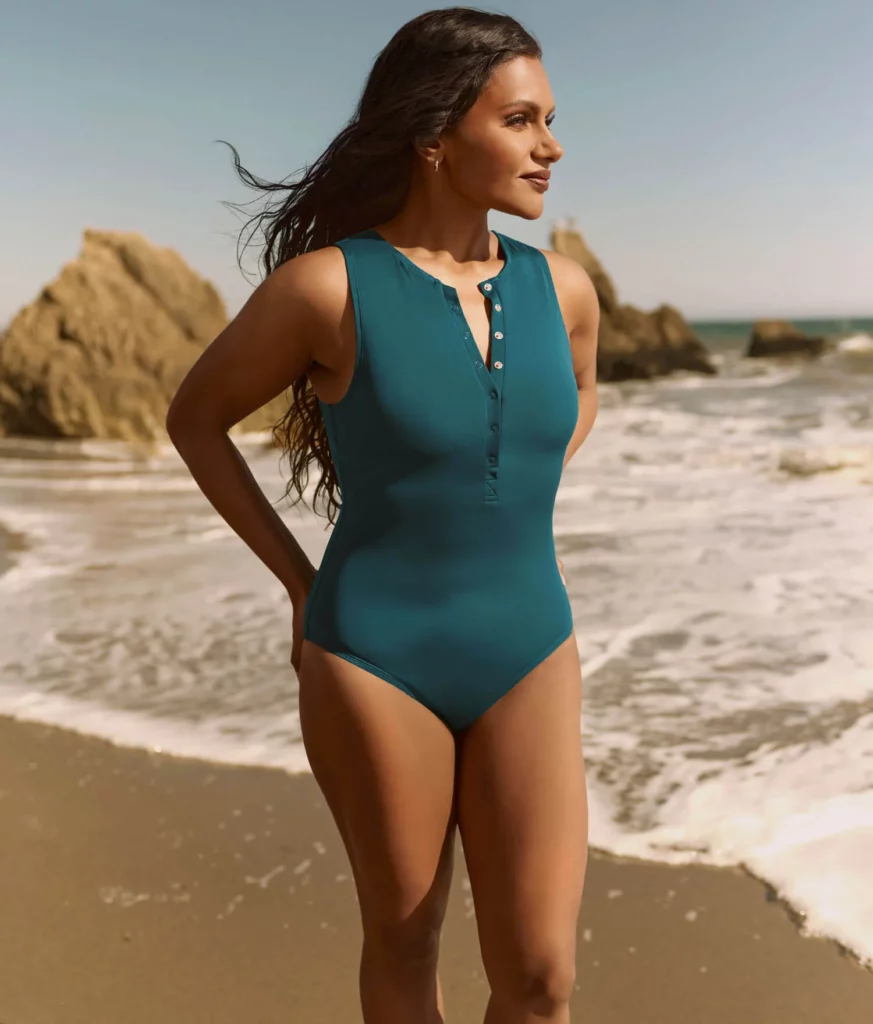As you go in search of your next swimsuit, you may notice a trend: there’s more eco swimwear available than ever before.
Vitamin A, the pioneering eco swimwear brand based in California, recently announced the launch of ReLux, a new line of swimwear made entirely from 100 percent recycled fabric. The material is the result of a collaborative effort between textile giants Hyosung and Hung Yen Knitting & Dyeing, marking a significant step forward in the industry’s move toward eco-friendly practices. The fabric is composed of an 80/20 blend, featuring Hyosung’s GRS-certified regen Ocean, which is made entirely from post-consumer nylon sourced from discarded fishing nets and RCS-certified 100 percent recycled regen Spandex.
Mark Sunderland, Vice President of Product Innovation at Swim USA, the parent company of Vitamin A, shared the motivation behind the development of the ReLux line. “Our customers expressed a desire for assurance that their swimwear does not harm the planet. With the introduction of the new ReLux line, they are now able to offer a product that actively contributes to the health of our oceans,” he said in a statement, underlining the brand’s response to growing consumer demand for sustainable and responsible fashion choices.
Vitamin A is just one of a growing number of swimwear brands leaning into sustainable materials. It was founded in 2000 by Amahlia Stevens, a California native who has since steered the company to become a leader in the sustainable swimwear category; it has consistently ranked among the top five sustainable swimwear brands in recent years. But it is far from alone. The swell of smaller niche swimwear labels bubbling up to the sustainable swimwear surface is also bringing innovative materials and practices to the forefront, like Carve and Londre, both of which make swimwear from yarn spun out of recycled water bottles. There’s Boden, Galamaar, and Do Good, which also use upcycled nylon made from discarded fishing nets, and Bold swimwear is made from a unique polyamide yarn that will completely break down in under five years in a landfill.

Last year, actor, writer, and producer, Mindy Kaling partnered with eco swimwear brand Andie Swim on a collection. The label uses material made from 80 percent recycled nylon. It also uses an eco-polyester material made from 87 percent recycled polyester. And then there are sportswear giants like Nike and Speedo both of which have also embraced eco materials for swimwear. According to Fortune Business Insights, Speedo’s 2022 swimsuit collection was manufactured with 82 percent recycled materials. Data insights from The Business Research Company show that sustainability is a driving factor behind the category’s 7.4 percent CAGR, driving the sector to nearly $25 billion this year.
One of the biggest reasons there’s a groundswell of players in the eco swimwear market is due in large part to the synthetic materials — chiefly spandex and nylon — that are used in most swimsuits. Swimwear materials are uniquely problematic; they are chosen for their durability, elasticity, and ability to dry quickly, but, the environmental impact of these synthetic fibers is significant, particularly as the fashion industry aims to reduce its carbon footprint. The fashion industry produces about ten percent of global greenhouse gas emissions, currently — much of that by way of virgin materials like polyester, nylon, and elastane, which are all byproducts of fossil fuels. Nylon production is particularly worrisome, producing an estimated 4.5 billion pounds of nitrous oxide each year — a toxic greenhouse gas 300 times more potent than carbon dioxide. Synthetic materials like nylon are inherently non-biodegradable — a problem using upcycled materials doesn’t address and one luxury label Prada has been actively working to replace. However, manufacturers using upcycled nylon do help reduce the amount of new synthetics being produced.
Voglia Swimwear founder Ashley-Victoria Smith says she was inspired to start her label in pursuit of a “cleaner, healthier, better world for us all,” something she says starts by cleaning up our oceans, waterways, and beaches, as well as saving marine life. She says that’s also why Voglia only uses regenerated nylon, eco-friendly inks, biodegradable shipping, and packaging, and eschews single-use plastics. Its latest collection goes a bit further inland and is an ode to honeybees; the label partnered with local beekeepers, with a portion of proceeds from each sale in the “Oh, Honey” collection going to support beekeepers’ initiatives. “By supporting local beekeepers, Voglia Swimwear not only honors honeybees but also contributes to the well-being of our ecosystems,” Smith says. “Bees are essential pollinators responsible for the reproduction of many of the fruits, vegetables, and flowers that make up a significant part of our diet and natural landscapes.”

Earlier this year, Under Armour announced a collaboration with Celanese Corporation on Neolast, a spandex-like textile that’s far more recyclable than conventional spandex. “This new Neolast fiber represents a transformative innovation for Under Armour and the textile industry, embodying our commitment to building better products for our consumers and planet,” Kyle Blakely, Senior Vice President of Innovation at Under Armour, said in a statement.
Outerknown, the eco clothing label started by world-renowned surf legend Kelly Slater, recently announced a collaboration with Seea — a line of swimsuits designed for surfing. Seea’s founder Amanda Chinchelli says she started the line out of necessity. “I needed suits that were comfortable for surfing, but didn’t look to sporty or too skimpy … something that looked good, while working great for surfing,” she says.
Even as the market shifts toward more sustainable swimwear materials, the most sustainable swimwear is the one already in your dresser, Diana Tsui, creative consultant and stylist, told CNN last year. And when it’s time for a new suit, opt for companies using sustainable materials. She recommends lookingfor B Corp certified brands, something she says is a “safe way to go,” especially if you’re short on time for in-depth research. “They adhere to a strict set of regulations to ensure both their fabrics and supply chain are sustainable and ethical.”
Related on Ethos:


